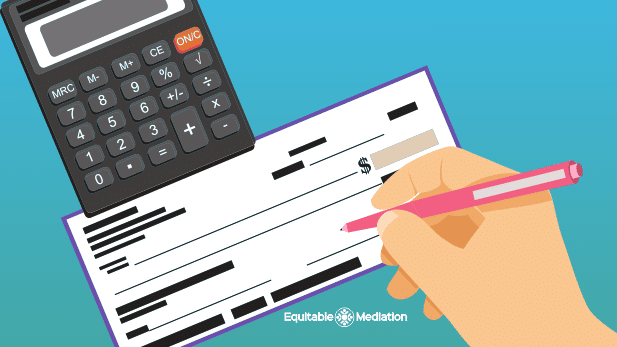Your marriage is ending and the same fears keep rushing through your head:
The house: “Will I have enough money to keep it?”
The bills: “How will I be able to pay them?”
Health insurance: “Will I be able to get coverage?”
Retirement: “Will there be any money left to save for the future?”
In divorce, all of these fears are normal and have the very same thing in common:
Money.
And when it comes to money and divorce, there's one issue that's more emotional, causes more disagreements and is more challenging to resolve than any other.
Whether you call it alimony, spousal support or spousal maintenance, New York couples needing to come to agreement on a matter that will require an ex-husband or wife to give money to their former spouse is challenging, to say the least.
And the topic of alimony in NY is a complicated one.
In this post, we'll take a closer look at this controversial and complex topic. And shed some light on what a divorcing couple can do to come to an alimony agreement they both find fair.
Note: For the purposes of this article, the terms alimony, spousal support and spousal maintenance are all used interchangeably because people search the web using all of these terms. However, in New York the preferred term is currently maintenance / spousal maintenance.
What is Spousal Support NY?
In its most common form, spousal maintenance is a payment made from one ex-spouse to the other over a pre-determined period of time, based on what was agreed to by the parties in their divorce decree.
And while most people commonly think payments are usually made after the marriage ends and divorce is final, that's not always the case when it comes to spousal maintenance. New York also allows for something commonly referred to as "temporary maintenance" or what lawyers may refer to as "alimony pendente lite."
Temporary maintenance may be paid from one spouse to the other while the couple is still married and going through divorce proceedings. Providing each party with a share of the marital income until a more permanent alimony number is agreed upon.
Any pendente lite alimony is based on the NY temporary maintenance calculator. Which due to recent alimony reform in New York, is now also used to determine alimony payments once a divorce is final.
How is Alimony Calculated in NY?
That will be covered in greater detail later in this article.
But as you'll learn, calculating alimony in New York is not as simple as it seems!
What Role Does Alimony in New York Play in Divorce?
For couples with children, spousal support is one of four topics that are discussed, negotiated, and agreed upon in divorce mediation along with:
- Parenting Plans - which outline the night, weekends, and holidays the children will spend with each of you; and
- Child Support - the amount of financial support each of you will provide your children for basics such as food and shelter as well as other "add-on" expenses such as daycare, education costs, etc.
- And Equitable Distribution - which outlines how you and your spouse will share in your marital assets and debts.
Unlike child support which is meant to assist with the children's expenses, spousal maintenance in New York is meant to assist with an ex-spouse's expenses.
I've had clients ask, "Do women pay alimony?" and the answer is - yes. It is strictly based on need and is gender-neutral. Meaning that both women and men can either pay spousal support or be eligible to receive it.
There are a few things you need to understand about the challenges of determining New York alimony:
- The New York maintenance calculator has significant restrictions, may produce an unexpected or unfair result, and may be deviated from by you and your spouse if you both agree;
- The NY State spousal maintenance formula employs an income cap, and any income which exceeds the cap, is excluded from the guideline's calculation, and must be negotiated separately;
- While inflationary pressures have eased in NYC and the state, interest rates remain elevated, and will continue to put pressure on the NYC real estate market, making establishing separate households for NY couples even more challenging in 2024;
- The topic of spousal maintenance in New York has less to do with formulas and more to do with money and negotiation;
- There is far more to this topic than a simple calculation and it is far too complex (and emotional) for you to try and resolve on your own.
That's why you’ll get the best outcome by mediating with us.

"With emotions running high and a New York maintenance calculator that allows for significant deviation by the parties and produces 'interesting' results, things can quickly go off the tracks if you involve attorneys.
That’s why it's better to work with an experienced divorce mediator like me.
I’ll take you through my proven, step-by-step process and help you and your spouse negotiate and come to an agreement on alimony in NY state that's fair to both of you."
- Divorce Mediator Joe Dillon
How Does the NYS Maintenance Calculator Work?
You would think having a calculator to determine maintenance in New York would make things easier. But it has only made matters more difficult.
Let's take a closer look at how the New York maintenance calculator works and the problems it can create in a New York divorce.
There are two methods for calculating spousal support in NY
Right off the bat, we start with controversy as there are two different ways you can calculate spousal maintenance in New York.
Method one:
- Take 20% of the payor's annual net income
- Subtract 25% of the payee's annual net income
- Divide by 12
Method two
- Take 40% of the combined annual net incomes of both spouses
- Subtract the annual net income of the recipient spouse
- Divide by 12
Which method you use depends on a number of factors including your respective incomes and whether or not you have children.
And since each method will produce different results, it's likely you and your spouse will be in disagreement right from the start.
Because if you're the one paying, you'll want to use the lower amount. But if you're the one receiving, you'll want to receive the higher amount!
There is an Upper Income Limit in the NY Spousal Support Calculator
Effective March 1, 2024, the NYS alimony calculator changed its upper-income limit to $228,000. This cap is revisited every two years.
That means for the purposes of calculating spousal support in NY, even if one spouse earns significantly more than $228,000 in net income, only the amount of earnings up to $228,000 will be considered in the guideline calculation.
For example, let's say one of you is working inside the home and caring for the children, while the other earns $500,000 working outside the home for a corporation. Resulting in a guess-timated net income of $400,000.
However:
- If you refer back to the first point, you see that the net income of the parties is used;
- And if you refer back to the second point, you see that there's an upper-income limit of $228,000 per the guideline
- But in our example, the net income is greater than $228,000
Now what?
If you go by what the guideline says, you'd base your calculation on $228,000, and not the actual net income.
So if you're the spouse paying support, you might find this to be fair. But if you're the one receiving support, you might not.
Spousal Maintenance Plays an Important Role in Determining Child Support
Since alimony in NY is considered income to the receiving party and a reduction in income to the paying party, it will impact the calculation of child support in New York.
So you can't just calculate child support or spousal maintenance in a vacuum - the two issues are tightly intertwined.
You need to resolve both issues simultaneously.
Here's what typically happens when people try to use divorce calculators on the Internet:
- They find a child support calculator and come up with an amount. That amount gets stuck in their head as what they think they're going to get or are entitled to.
- Then they go and find a spousal support calculator and do the same thing. Away they go, numbers in hand, never thinking for a second that those numbers could be way off base.
- Now it comes time for them to agree on child support and spousal maintenance. And one or both of them have some "calculated numbers" in their head about how it's going to be.
And all of their numbers are wrong.
So they'll argue and never come to an agreement because each of them thinks they're right.
If they then involve attorneys, round and round they'll go, ultimately winding up in family court. And before long, they'll have spent more on legal fees than the difference in the amounts of child support and maintenance they were arguing about in the first place!
Starting to understand why the New York State alimony calculator can complicate resolving maintenance?
Even Though There is a New York Spousal Support Calculator, the Output is Only a Suggestion
Even though there is a spousal maintenance calculator, New York allows divorcing couples to deviate from the amount it outputs provided the two spouses can agree on an alternate amount.
So after all those calculations and gyrations to determine net income and upper-income limitations, you can choose to bypass the result and come to an amount you both think is fair instead.
There is No Such Thing as an "Average Alimony Payment" in NY
When you hear the word "calculator," you might think, "Oh good, the calculator will tell me what some typical alimony payment will look like. I'll throw a few options in there, push the button and I'll be all set."
But not only can you choose to deviate from what the maintenance calculator suggests on a case-by-case basis (see issue #4 above), but you and your spouse can also define what "counts" as income.
Remember when I said you have to solve both child support and alimony in NY simultaneously? Well, add equitable distribution into that mix as well.
In New York, any income generated from investments, rental properties, etc. also counts as income in the alimony calculation.
So if you have income-producing assets like a mutual fund portfolio or rental property, until you determine which assets each of you is going to receive in the divorce, you can't settle on an alimony amount.
Just one more reason this issue is far too complex and emotional to try and resolve on your own!
When Figuring Out Alimony in NYS, Don't Forget About Cost of Living.
As if figuring out spousal maintenance in New York wasn't hard enough, we've got yet one more factor to toss in. The cost of living.
Say your marital home was in White Plains. And you're the one paying alimony.
But because you work in Manhattan, and are tired of the commute, you decide to move to New York City, post-divorce. You're going to need some serious coin to do that!
So do you pay him or her less because you need to keep more money to move to NYC? Or do you pay based on what it will cost them to keep living in Westchester, and you'll just have to figure out how to make it work?
Good question...
How Long Do You Have to be Married to Get Alimony in NY?
In addition to agreeing on an amount of spousal maintenance, you and your spouse also need to agree on how long it will last, aka duration.
How long do you have to pay alimony is based on how long you've been married. And just like the New York maintenance calculator outputs an amount, it also outputs a duration.
Just like the amount, the alimony duration may be deviated from if you and your spouse agree.
To give you an idea of how long do you pay alimony, the NY duration guidelines are as follows:
- If your marriage lasted up to 15 years, the duration of maintenance may be between 15% and 30% of the total time you were married; or
- If your marriage is between 15 years and 20 years, the duration of maintenance may be between 30% and 40% of the total time you were married; or
- If your marriage lasted more than 20 years, the duration of maintenance may be between 35% and 50% of the total time you were married.
But much like using the guideline to determine an amount, there are also issues with using it to determine duration.
The Guideline New York Spousal Support Duration May Adversely Affect Your Children
Let's say you and your spouse have two children, ages 8 and 11, and were married for 14 years. You desperately want to keep the kids in the home but you're a stay-at-home parent and haven't worked outside the home in more than 10 years. So because your job prospects and earning potential will be extremely limited, you'd be relying heavily on alimony.
Per the guidelines above, the suggested duration of alimony in NY would be between 2.1 and 4.2 years. So if support were to end even at the upper range of the duration (4.2 years), at that time, one of your children would be 15 and most likely a sophomore in high school, and the other would be 12 years old and in middle school.
Is that really the best time to have to move them out of their house and away from their school and friends?
Is it in their best interests? Or what you want for them as mom or dad?
The Duration of NYS Alimony May Create Unintended Consequences
Now let's go back to the same example (the kids are 15 and 12 when spousal maintenance ends) but this time, both you and your spouse work full-time at a corporation. Given the ages of your kids, you might determine they are old enough to be left alone for a bit between the time they get home from school and the time you get home from work.
But what if your marriage was shorter in duration? And your children were much younger?
Let's say you and your spouse have been married 6 years and have a 3-year-old and a 1-year-old. The range for the duration of spousal maintenance would be between 11 months and 1 year and 10 months.
In this case, the spouse who is caring for the children would have no choice but to go back to work before the children reached school age. Thus creating incredible scheduling difficulties with respect to child care, and also incurring tremendous childcare costs.
Have you ever priced out daycare for young kids? Yikes!
In this case, it may actually be more cost-effective for one spouse to stay home with the children. But if you strictly follow the guidelines on duration for alimony in NY, that might not be possible.
When thinking of spousal support New York, most people think of the "check in the mail" approach.
While technically there are only two types of alimony in NY - temporary maintenance and spousal maintenance - there can be other, more creative ways to resolve this issue because some people just don’t like paying alimony.
For example, sometimes divorcing spouses will trade alimony for equitable distribution (marital property and/or other assets). Or do lump sum alimony or an alimony buyout.
Another option that isn't explicitly mentioned in New York but can also be an option is something called rehabilitative alimony.
Where instead of paying an ex-spouse money every month just to cover their expenses, they instead pay for them to go back to school. In turn, earning a degree and improving their earning potential.
The bottom line is there’s no such thing as "typical alimony." And there are many different ways to resolve this issue.
When you involve lawyers in spousal maintenance, New York couples have problems.
 Because the New York maintenance calculator allows for deviation from its output and has a number of limitations and requirements on income, if you go the attorney route, your lawyers can drag your negotiations on forever.
Because the New York maintenance calculator allows for deviation from its output and has a number of limitations and requirements on income, if you go the attorney route, your lawyers can drag your negotiations on forever.
Fighting and fighting. Around and around in circles - in a very gray area. All while billing you their outrageous hourly fees.
Until neither you nor your spouse has any money left to keep paying your legal fees.
And there's no money left for alimony!
Just one more reason it’s better to not involve lawyers in your divorce negotiations.
When a judge gets involved in spousal support, NY couples have problems.
 If alimony can’t be successfully resolved between you, your spouse, and your respective attorneys, your case will continue to divorce litigation.
If alimony can’t be successfully resolved between you, your spouse, and your respective attorneys, your case will continue to divorce litigation.
And if the issue cannot be resolved between the two of you and your lawyers, your case will go to court.
There’s something you need to understand here: In a litigated divorce, a family court judge determines who gets what.
Sounds scary, doesn’t it?
Because they’ll dictate the terms of the settlement and tell you what you’re going to pay or receive.
And each of you might wind up with an alimony outcome you don’t think is fair or that doesn’t meet your needs.
That’s why it’s better to negotiate an amount and duration each spouse finds fair out of court. And negotiation is exactly what NY divorce mediation is all about.
In mediation, you get to decide - and come to an agreement you both agree is fair, instead of letting your future be decided by a stranger.
You’ll get the best New York alimony result by mediating.
 Using our extensive financial knowledge of the complex matters of alimony and spousal maintenance, we'll help you determine an appropriate amount and/or duration of temporary alimony and post-divorce spousal maintenance in your New York divorce.
Using our extensive financial knowledge of the complex matters of alimony and spousal maintenance, we'll help you determine an appropriate amount and/or duration of temporary alimony and post-divorce spousal maintenance in your New York divorce.
One that works for you and your children. And regardless of what the NY spousal maintenance guideline imposes upon you.
We'll also explore a variety of alimony types and balance them against both child support and equitable distribution since as we learned above, all three topics are inter-connected.
We’ll actively guide you through our comprehensive budgeting process to reflect your marital as well as projected post-marital expenses. So we can take a close look together at what each of you earns, spend, and will need to move forward.
We’ll then help you negotiate an alimony result you both find fair and will best enable both of you to meet your financial obligations after you're divorced.
And since we offer all-inclusive, flat-fee mediation services, we have no vested interest in prolonging the conflict because we don’t bill you hourly like a lawyer would.
Equitable Mediation enables you to get a fair outcome regarding spousal support in NY.
 Why be forced to accept a settlement created by a family law attorney or judge in court when you can have a direct say in your financial future instead?
Why be forced to accept a settlement created by a family law attorney or judge in court when you can have a direct say in your financial future instead?
If you want to arrive at an agreement on alimony that’s fair to each of you and doesn’t bankrupt you in the process, mediate your divorce with Equitable Mediation.
If you and your spouse have both agreed to divorce and want to mediate out of court, take the next step and book a mediation strategy session for the two of you.
Other Useful Resources:




 Because the New York maintenance calculator allows for deviation from its output and has a number of limitations and requirements on income, if you go the attorney route, your lawyers can drag your negotiations on forever.
Because the New York maintenance calculator allows for deviation from its output and has a number of limitations and requirements on income, if you go the attorney route, your lawyers can drag your negotiations on forever. If alimony can’t be successfully resolved between you, your spouse, and your respective attorneys, your case will continue to divorce litigation.
If alimony can’t be successfully resolved between you, your spouse, and your respective attorneys, your case will continue to divorce litigation. Using our extensive financial knowledge of the complex matters of alimony and spousal maintenance, we'll help you determine an appropriate amount and/or duration of temporary alimony and post-divorce spousal maintenance in your New York divorce.
Using our extensive financial knowledge of the complex matters of alimony and spousal maintenance, we'll help you determine an appropriate amount and/or duration of temporary alimony and post-divorce spousal maintenance in your New York divorce. Why be forced to accept a settlement created by a family law attorney or judge in court when you can have a direct say in your financial future instead?
Why be forced to accept a settlement created by a family law attorney or judge in court when you can have a direct say in your financial future instead?